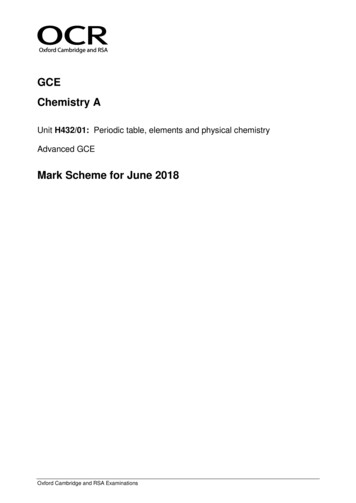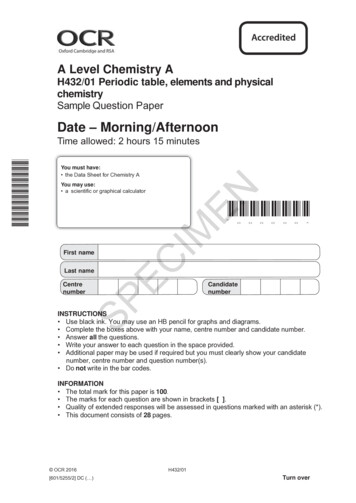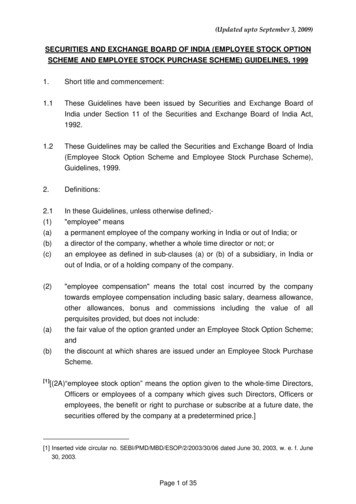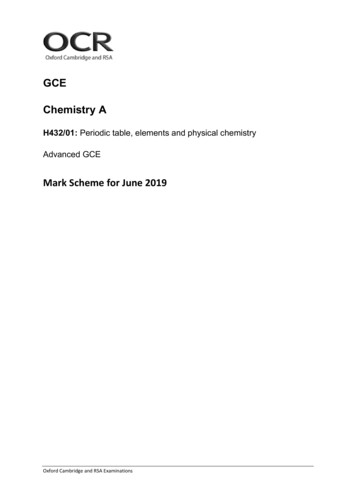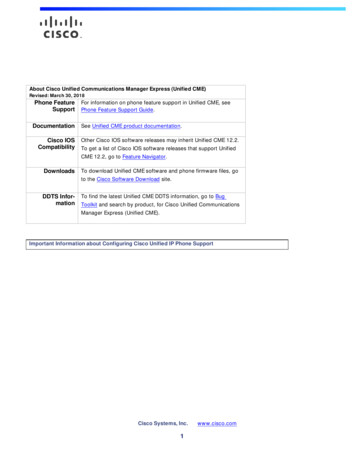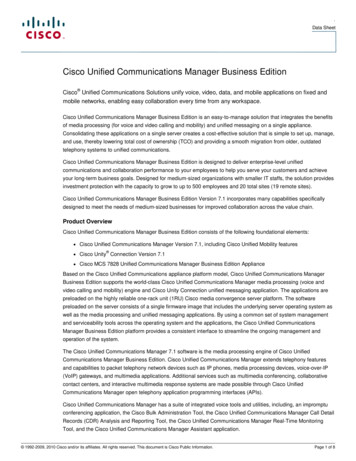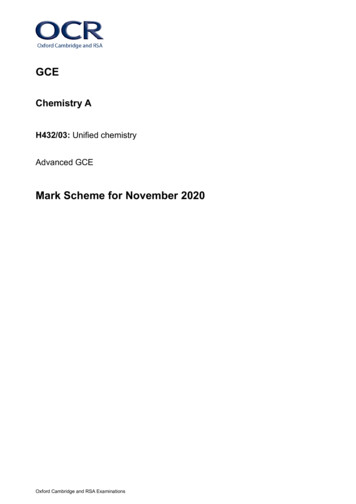
Transcription
GCEChemistry AH432/03: Unified chemistryAdvanced GCEMark Scheme for November 2020Oxford Cambridge and RSA Examinations
OCR (Oxford Cambridge and RSA) is a leading UK awarding body, providing a wide range ofqualifications to meet the needs of candidates of all ages and abilities. OCR qualificationsinclude AS/A Levels, Diplomas, GCSEs, Cambridge Nationals, Cambridge Technicals,Functional Skills, Key Skills, Entry Level qualifications, NVQs and vocational qualifications inareas such as IT, business, languages, teaching/training, administration and secretarial skills.It is also responsible for developing new specifications to meet national requirements and theneeds of students and teachers. OCR is a not-for-profit organisation; any surplus made isinvested back into the establishment to help towards the development of qualifications andsupport, which keep pace with the changing needs of today’s society.This mark scheme is published as an aid to teachers and students, to indicate the requirementsof the examination. It shows the basis on which marks were awarded by examiners. It does notindicate the details of the discussions which took place at an examiners’ meeting before markingcommenced.All examiners are instructed that alternative correct answers and unexpected approaches incandidates’ scripts must be given marks that fairly reflect the relevant knowledge and skillsdemonstrated.Mark schemes should be read in conjunction with the published question papers and the reporton the examination. OCR 2020Oxford Cambridge and RSA Examinations
AnnotationsAnnotationMeaningCorrect responseIncorrect responseOmission markBenefit of doubt givenContradictionRounding errorError in number of significant figuresError carried forwardLevel 1Level 2Level 3Benefit of doubt not givenNoted but no credit givenIgnore
Abbreviations, annotations and conventions used in the detailed Mark Scheme (to include abbreviations and subject-specificconventions).AnnotationDO NOT ALLOWMeaningAnswers which are not worthy of creditIGNOREStatements which are irrelevantALLOWAnswers that can be accepted()Words which are not essential to gain creditUnderlined words must be present in answer to score a markECFError carried forwardAWAlternative wordingORAOr reverse argument
H432/03Mark SchemeQuestion1(a)Answer(i)Marks2Oct 2020AOelement1.2 2GuidancePear-shaped /Round-bottomflaskWater flow AND condenserWater in at bottom and out at topAND condenser Flask and techniquePear-shaped/round-bottom flaskAND reflux DO NOT ALLOW conical flask, volumetric flask,beaker in place of round bottom/pear shaped flask
H432/03Mark SchemeQuestion(ii)AnswerMarksDiagram showing knowledge of filtration underreduced pressureDiagram showing Buchner flaskmust have ONE side armANDBuchner/Hirsh funnel on top of flask Labels not required2Oct 2020AOelement2.3GuidanceLabels NOT required for diagramALLOW diagram of a conical flask with a filteringsetup aboveANDSide arm either in conical flask OR between flaskand filter paper of funnelIGNORE absence of seals---------------------------------Further details: ---------------------------------MUST imply some type of seal between filter setupand flask. ALLOW small gapsFunnel sealed or stoppered to flaskAND Apparatus capable of filtering under reduced pressureAND Label for setup from side arm to indicate reducedpressure2.7AND Label for Buchner flask OR Buchner/Hirsh funnel ALLOW slips in spelling of ‘Buchner’Examples of suitable labels (may have arrow fromside arm or tube attached) to pump to vacuum air out suction reduced pressure etc.For Buchner flask and Buchner funnelDO NOT ALLOW just ‘flask OR ‘funnel’Flask and funnel used in normal filtration7
H432/03Mark SchemeQuestion(b)(i)AnswerMarks5 4 maxComparison of branching and points of contacte.g. CH3CH2CH2NH2 has longer chain / straightchain / no branchesANDe.g. CH3CH2CH2NH2 has more points of contact /more surface interaction (between molecules) Oct 2020AOelement1.2Relative strength of forcee.g. CH3CH2CH2NH2 has stronger/moreinduced dipole(–dipole) interactionsOR London forces --------------Hydrogen bondsCH3CH2CH2NH2 OR (CH3)2CHNH2 havehydrogen/H bondsOR(CH3)3N has no hydrogen/H bonds GuidanceANNOTATE WITH TICKS AND CROSSES, -------------------ALLOW ORA throughoutALLOW ‘The straighter the chain, the more pointsof contact .’IGNORE comparison using ‘primary’, ‘secondary’and ‘tertiary’.Comparison of branching is required.For London forces, ALLOW induced dipole(–dipole) interactions IGNORE IDID OR van der Waals’ forces/VDWDO NOT ALLOW CH3CH2CH2NH2 has moreelectrons(number of electrons are the same)1.2Relative strength of forceHydrogen bonds are stronger than London forces/permanent dipole interactions ---------------Comparison of energy required to break forceDO NOT ALLOW ‘more energy to break covalentbondse.g. More energy to break/overcome Londonf orces/intermolecular f orces in CH3CH2CH2NH2ORMore energy is needed to break H bonds (thanLondon forces) 2.18ALLOW little energy is required to break Londonforces (compared with H bonds)
H432/03Question(b) (ii)Mark SchemeAnswerMarksFIRST CHECK MOLECULAR FORMULA andSTRUCTUREIF molecular formula C5H13N AND correct structureAND evidence of ideal gas equation 6 marksCorrect up to 87 AND C5H13N 5 marksCorrect up to 87 4 ----------------------------Rearranging ideal gas equationpVn RTpVUnit conversion AND substitution into n :RT R 8.314 OR 8.31 V 72(.0) 10–6 T in K:373 K51.00 10 72.0 10–6e.g. 8.314 373Calculation of n6Oct 2020AOelementGuidancepVis omitted, ALLOW when values areRTsubstituted into rearranged ideal gas equation.IF n 2.2 4n 2.32 10–3 (mol) Calculator: n 2.321740325 10–3 from 8.314From 8.31, n 2.322857889 10–3Calculation of M0.202M 87 2.32 10–3Molecular formulaC5H13N Molecular formula required3.2ALLOW elements in any orderALLOW molecular formula C3H9N3ALLOW other molecular formulae of an amine thathas M 87, e.g. C4H9NO9
H432/03Mark SchemeQuestionAnswerMarksOct 2020AOelement3.2Structure of amine A from C5H13N GuidanceALLOW any combination of skeletal OR structuralOR displayed formula as long as unambiguousALLOW structures below frommolecular formula C3H9N3ORALLOW ECF but only if structure has calculated MrAND has 3 peaks in 13C NMR spectrum.ORUse of24000OROR3 marks max possible for use of 72.0 cm3 OR 0.720 dm3 by ECFCalculation72.0 3.00 10–3 No mark (calculation much simpler)e.g. n 240000.202M 67.3 OR 67 ECF3.00 10–3 ECFMolecular formula C4H5NStructure ECF10
H432/03Mark SchemeQuestionAnswerMarks(c)2Oct 2020AOGuidanceelement3.2ALLOW any combination of skeletal OR structuralOR displayed formula as long as unambiguousALLOW Organic product and water marked independently.1st markNOTE: For ECF, any structure must have correctnumber of bonds to C, H, O and Ncorrect organic product OR waterIGNORE balancing numbersDO NOT ALLOW structure of dimerQuestion states molecular formula C3H3NO2nd mark BOTH products AND correctly balanced.Total1116
H432/03Mark SchemeQuestion2*AnswerMarksRefer to marking instructions on page 5 of mark scheme forguidance on marking this question.6Oct 2020AOGuidanceelementIndicative scientific points may include:1.1 4Terms2.1 2 Level 3 (5-6 marks)Comprehensive explanation of the terms, ligand andcoordination number and ligand substitutionAND3D diagrams of suitable examples of 6 AND 4 coordinatecomplex ions with different shapesANDLigand substitution illustrated with a balanced equation Ligand: Donates a lone pair to metal ionForms dative covalent (coordinate) bond with metal ionCoordination number: Number of coordinate bondsto metal ion. Could be implicit in annotated diagramsNOTE: For monodentate ligands, ‘number of ligands’is the same as the number of coordination numberLigand substitution: One ligand replacing anotherSuitable examples of complex ions with different shapesThere is a well-developed line of reasoning which is clearand logically structured. The information presented isrelevant and substantiated.Level 2 (3-4 marks)Explanation of the terms, ligand and coordination numberand ligand substitution with some errors or omissionsAND:Diagrams of suitable examples of 6 AND 4 coordinatecomplex ions with different shapesORA 3D wedged diagram of a suitable example of 6 OR 4coordinationORA diagram of a suitable example of 6 OR 4 coordinationAND ligand substitution illustrated with an equationORLigand substitution illustrated with a balanced equation Coordination no 6Octahedral e.g. [Cu(H2O)6]2 , [Fe(H2O)6]3 Coordination no 4Tetrahedral e.g. CuCl42–, CoCl42–OR Square planar Pt complexes, e.g. Pt(NH3)2Cl2Diagrams and equations Diagrams of complex ions (may be 3D)Equation for ligand substitutione.g. [Cu(H2O)6]2 4Cl– CuCl42– 6H2O[Cu(H2O)6]2 4NH3 [Cu(NH3)4(H2O)2]2 4H2ONOTE: A clear and logically structured responsewould link shapes with some of: coordination number,names of shapes, connectivity, involvement of lonepairs, bond angles, etc. (not inclusive)ALLOW minor slipsThere is a line of reasoning presented with some structure.The information presented is relevant and supported bysome evidenceNOTE: Levels and the mark within a level is a‘best-fit’, not perfection12
H432/03Mark SchemeQuestionAnswerMarksLevel 1 (1-2 marks)Explanation of some terms: ligand, coordination number andligand substitution with some errors or omissions.ANDA suitable example of a complex ion OR Ligand substitutionillustrated with an equation with some errorsThere is an attempt at a logical structure with a line ofreasoning. The information is in the most part relevant.0 marksNo response or no response worthy of credit.Total613Oct 2020AOelementGuidance
H432/033Mark SchemeOct 2020QuestionAnswerMarks(a)FIRST, CHECK THE ANSWER ON ANSWER LINEIF cH –1860 OR –1850 (kJ mol–1) with evidence ofworking, award 3 marksIF cH –1862, award 2 marks (not 3 ----------------Energy released in J OR kJ 100 4.18 24.5 10241 (J) OR 10.241 (kJ) 3 SF minimum required3(i)AOelement2.4Calculates n(C3H8)0.242 0.0055(0) (mol) 44(.0)2.4Calculates cH with – sign AND 3 SF (appropriate)10241 –1862No mark cH 0.0055 10002.8 –1860 OR –1.86 103 (kJ mol–1) – sign AND 3 SF requiredGuidanceFULL ANNOTATIONS MUST BE -----------------ALLOW ECF throughoutDO NOT ALLOW c 4.2 10290Next 2 marks available by ECF –1870ALLOW 10240/10200 J OR 10.24/10.2 kJIGNORE unitsALLOW ECF from initial 3 SF rounding to 10.2 kJ:10200 1854.545455 1850 0.0055 -------------------Common errors H –54.6 OR –54.7 2 marks by ECF from mc Tm wrong as 0.242 and T wrong as 297.5 K) mc T wrong as 300.9391 (J)2 marks by ECF from mc T H –4.51m wrong as 0.242 and T correct as 24.5) mc T wrong as 24.78322 (J) H –226002 marks by ECF from mc Tm correct as 100 and T wrong as 297.5) mc T wrong as 124355 (J)(a)(ii)Any two from:1 MARK ONLY Heat loss/released to surroundings Incomplete combustion/reaction with oxygen or airOR not everything burns Evaporation of water11.2IGNORE incomplete ‘reaction’Needs link to combustion/burning/reaction withair/O2IGNORE evaporation of C3H814
H432/03Mark SchemeQuestion(b)*AnswerOct 2020Marks6Refer to marking instructions on page 5 of mark scheme forguidance on marking this question.Level 3 (5-6 marks)Calculates rH f or reaction 3.1 correctly with correct signANDCalculates a value f or cH o of propaneusing rH AND 4 vapHThere is a well-developed line of reasoning which is clear andlogically structured. The information presented is relevant andsubstantiated.AOGuidanceelementIndicative scientific points may include:2.4 23.1 2Bond enthalpy calculation of r H3.2 2Bonds broken (2 347) (8 413) (5 498) (694) (3304) (2490) 6488 kJ mol–1Bonds made (6 805) (8 464) (4830) (3712) 8542 kJ mol–1 r H 6488 – 8542 –2054 kJ mol–1Level 2 (3-4 marks)NOTE: 3 C–C 6835 f or bond broken: H –1707There is a line of reasoning presented with some structure.The information presented is relevant and supported by --------Determination of cH(C3H8) cH o of propane using r H AND 4 vap HCorrect cH(C3H8) rH – 4 vapH –2054 – (4 40.65) –2054 – 162.6 –2216.6 / –2217 kJ mol–1Incorrect cH(C3H8) –2054 (4 40.65) –2054 162.6 –1891.4 / –1891 kJ mol–12 C–C omitted f rom bonds broken gives: H –2748Calculates rH f or reaction 3.1 correctly with correct signORCalculates bonds broken OR bonds made correctly toobtain a value of rH f or reaction 3.1AND attempts to link rH with vapH OR calculates 4 vapHLevel 1 (1-2 marks)Uses bond enthalpies for bonds broken and bonds made butmay contain errors or omissions AND obtains a value for rH.ORCalculates bonds broken OR bonds made correctly.NOTE: A clear and logically structured response wouldThere is an attempt at a logical structure with a line ofreasoning. The information is in the most part relevant.0 marksinclude a correct energy cycle for cH(C3H8)using rH AND 4 vapH in energy cycle or expression:No response or no response worthy of credit.ALLOW trailing zeroes OR minor slipsTotal1510
H432/03Mark SchemeQuestion4(a)AnswerOct 2020Marks(i)3AOelement2.6 3GuidanceAll 3 marks are independent.IGNORE charges/oxidation numbers shown aroundoverall equation.Treat as rough workingALLOW overall equation shown with some or allions that are presente.g. (with state symbols)M 2H M2 H2M 2HCl M2 2Cl– H2M 2H 2Cl– M2 2Cl– H2In half equations,IGNORE state symbols even is wrong BUT halfequations MUST only have species that change.Overall equation AND state symbols:M(s) 2HCl(aq) MCl2(aq) H2(g) STATE SYMBOLS required in overall equation ONLYHalf equations:Oxidation M M2 2e– Reduction 2H 2e– H2OR H e– ½H2 For charges on half equations,ALLOW M 2 for M2 ORALLOW M – 2e– M2 H 1 for H If BOTH half equations are correct but shown withoxidation and reduction the wrong way around,award 1 mark from the 2 marks for half equations(a)(ii)2Bubbles/effervescence/fizzing stops 3.3 2M/metal/solid has disappeared/dissolved (a)(iii) H OH– H2O 12.5Responses must imply that all fizzing has stoppedand that all the solid has dissolvedi.e. ‘metal disappears’ is not quite enough.‘All the metal disappears’ is enoughIGNORE constant massIGNORE no increase in temperatureALLOW multiplese.g. 2H 2OH– 2H2OIGNORE state symbols, even if wrong16
H432/03Mark SchemeQuestion(a)AnswerOct 2020Marks(iv) Mean titre1 mark(27.30 27.20) 27.25 (cm3) 2Analysis of results5 marks0.320n(NaOH) 27.25 8.72 10–3 (mol) 10006AOelement2.8 5TAKE CARE: Value written down may betruncated calculator value.Depending on rounding, either can be credited.n(HCl) that reacted with M 0.210 – 8.72 10–2 0.1228 (mol) Ar of M FULL ANNOTATIONS MUST BE -----------------Common error:Incorrect mean from all 3 titres 27.35 cm3Use ECF throughoutIntermediate values for working to at least 3 SF.n(HCl) in 25.0 cm3 n(NaOH)n(HCl) in 250 cm3 8.72 10–3 10 8.72 10–2 (mol) n(M) that reacted GuidanceALLOW 0.123 (mol)i.e. 3SFALLOW 0.0615 (mol) IF 0.1228 rounded to 0.1230.1228 0.0614 (mol) 26.90 112.4 AND M cadmium/Cd 0.06143.2ALLOW 112.2 from 0.0615 AND CdALLOW Ar to nearest whole numberALLOW ECF for metal closest to calculated ArDO NOT ALLOW Ga OR Sc (Form 3 ions only)No 10 to obtain n(HCl) in 250 cm35 marks–30.210 – 8.72 10 0.20128 OR 0.201n(M) 0.20128/2 0.10064Ar 6.90/0.10064 68.56 ZnCOMMON ERRORS:Mean of 27.35 (use of all 3 titres) 8.752 10–3 8.752 10–2 0.12248 0.06124 112.7 AND Cd:5 marksNo 2 to obtain n(M) 56.2 AND Fe (from 27.25)5 marks 56.3 AND Fe (from 27.35)4 marksNo subtraction from 0.2106.90 8.72 10–2/2 4.36 10–2 4.36 10–2 158.2 to 158.3 AND Tb5 marksNo 10 and no 20.210 – 8.72 10–3 0.20128Ar 6.9/0.20128 34.28 Ca4 marksOmitting initial titration calculationZero marks0.210/2 0.105 6.9/0.105 65.71 Zn17
H432/03Mark SchemeQuestion(b)(i)(b)(ii)AnswerMarks12.75 0.0625 (mol) 44n(X2CO3) 0.0625 (mol)OR0.0625 used in molar mass expression below n(CO2) Molar mass of X2CO3 Metal XOct 2020AOelement2.83GuidanceALLOW ECF from 4b(i)1.214.57 233.12 (g mol–1) 0.06252.83.2 Rubidium/Rb ALLOW to nearest whole numberDO NOT ALLOW strontium/Srwrong carbonate ---------------------ALLOW ECF for X from calculated molar massONLY IF X is a Group 1 metal OR AgWorking:Mass of X in X2CO3 233.14 – 60 173.12 OR 173173.12OR 86.56 OR 85.6 OR 872ALLOW response implying leaving for longer andmonitoring by reweighing to constant mass,e.g. Leave flask until the mass does not changeAr of X (c)(i)1Reweigh to constant mass 3.4IGNORE ‘leave for longer’ OR wait till fizzing stopsNeeds link to constant mass(c)(ii)Mass (CO2) OR n(CO2) loss would be smallerORALLOW Collect gas until gas volume is constant2Mass X2CO3 OR n(X2CO3) reacted (seems to be) less 3.1Molar mass would be greater 3.2Total1819
H432/03Mark SchemeQuestion5(a)AnswerOct 2020Marks2AOelement1.2 2GuidanceT /KKp1T/K–15005.86 10456001.83 10377001.46 10318001.14 10262.00 10–31.67 10–31.43 10–31.25 10–3 ALLOW 2 SF or more for 1/T but ignoretrailing zeroesln Kp105867260 ALLOW whole numbers ( 1) for ln KpCalculator values1/T /10–3ln Kp2.00105.38447881.66 recurring1.42857142985.7999644171.75857432Mark by rowALLOW 1 small slip in each row.e.g. 1.66 for 1.67; 71.7 for 71.8Check with calculator values below table1.2559.99824068BUT DO NOT ALLOW whole number errors,e.g. 85 for 86 (b)1Equilibrium (position) shifts to the leftAND(forward) reaction is exothermic 2.2ALLOW ‘favours reverse reaction’Implies shift to leftALLOW ‘shifts in endothermic direction’ BUTonly if (forward) reaction stated as exothermic19
H432/03Question(c)Mark SchemeAnswerOct 2020MarksPlotting of graphAll points correctly plottedAND best-fit straight line 4Guidance3.1GradientCorrect gradient of best-fit straight line within the range 57000 63000 3.1 H calculation (subsumes mark for gradient) H (–) gradient 8.31(4) OR calculated value e.g. from 60000, H ( )498840 (J) OR 498.840 (kJ)3.2ALLOW 4 points on graphTolerance 1 small square H in kJ mol–1 H correct in kJ mol–1AND 3SFAND – sign e.g. from 498840, H –499 (kJ mol–1)(d)AOelement3.2Extrapolate line to (y) intercept OR Measure/Use (y) intercept SIntercept OR S R (y) intercept RThis statement automatically subsumes 1st markNOTE: If ‘x’ intercept, DO NOT ALLOW 1st mark but 2nd markavailable for R as BODTotal2023.1 2ALLOW H in range: –480 –530 (kJ mol–1)This mark subsumes gradient markALLOW substitute values of ln Kp, 1/T andgradient into Equation 5.1 From provided values and gradient 60000: S ROR9ln Kp – gradient 1/T135 – 60000 2.50 10–3 –15
H432/03Mark SchemeQuestion6(a)AnswerBond angle120( )104–105( )Marks2Name of shapeOct 2020AOelement1.2 2Trigonal planarNon-linearFor non-linear,ALLOW bent, v-shaped, angularIGNORE planar, ‘not straight’Mark by row OR by column to give higher marki.e.ORi.e.(b)2 bond angles correct 2 shapes correct bond angle AND shape correct in 1st row bond angle AND shape correct in 2nd row CH3SO2OH H2OCH3SO2O– H3O A1GuidanceB2B1A242.1 2ALLOW acid–base pairs labelled other way round.CH3SO2O– H3O i.e. CH3SO2OH H2OA2B1B2A1ALLOW small slip For an equilibrium shown using CH3COOH instead ofH2O, mark acid–base pairs by ECF, i.e.CH3SO2OH CH3COOHA1B2ALLOW forCH3SO2O– CH3COOH2 B1A2 ECF CH3SO2OH dissociates more (than CH3COOH)OR CH3SO2OH is a stronger acid If ONE charge is missing from equilibrium.ALLOW ECF for acid–base pairs mark3.1ORA in terms of CH3COOH being a weaker acidIGNORE ‘more acidic’Response needs strength/dissociationALLOW maths explanation for final 2 marks, e.g.Ka(CH3COOH) 10–(4.76) 1.74 10–5[H ] (1.74 10–5) 1) 4.17 10–3pH –log 4.17 10–3 2.38 Student is correctAND(sulfonic acid has) lower pKa/higher Ka OR greater [H ]ORA 3.221Ka(CH3SO2OH) 10–(–1.90) 79.4[H ] (79.4) 1) 8.91pH –log 8.91 –0.95 BOTH pH calcs subsumes ‘Student is correct’
H432/03QuestionMark SchemeAnswerMarks(c)4Oct 2020AOGuidanceelementIGNORE any added charges OR dipoles.3.1 4Marks solely for curly arrowsIGNORE any curly arrows on bottom structures(not in boxes):6 curly arrows correct 5 curly arrows correct 4 curly arrows correct 3 curly arrows correct Total2210
OCR (Oxford Cambridge and RSA Examinations)The Triangle BuildingShaftesbury RoadCambridgeCB2 8EAOCR Customer Contact CentreEducation and LearningTelephone: 01223 553998Facsimile: 01223 552627Email: general.qualifications@ocr.org.ukwww.ocr.org.ukFor staff training purposes and as part of our quality assurance programme your call may berecorded or monitored
H432/03: Unified chemistry . Advanced GCE . Mark Scheme for November 2020 . Oxford Cambridge and RSA Examinations . OCR (Oxford Cambridge and RSA) is a leading UK awarding body, providing a wide range of . indicate the details of the discussions which took place at an examiners' meeting before marking commenced.

